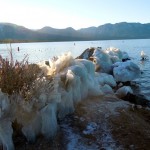Precautions urged to deal with ongoing cold temps
The California Emergency Management Agency is urging residents throughout the state to accelerate their winter weather preparedness efforts in response to a forecast by the National Weather Service for temperatures in the 20s to low 30s and possibly lower later this week.
It’s not just the Lake Tahoe area that is feeling the big chill. Freezing temperatures striking throughout much of Northern California.

After last week's high waves, ice now covers the rocks leading to the Tahoe Keys Marina. Photo/Kathryn Reed
“According to the National Weather Service, residents in much of Northern California can expect extremely cold temperatures during the next several days,” Cal EMA Acting Secretary Mike Dayton said in a press release. “As this weather tends to be the norm throughout the winter months, it is critical that Californians recognize the risks associated with freezing temperatures and take necessary steps to prepare if they have yet to do so.”
Prolonged exposure to cold temperatures can cause hypothermia and other serious health problems, particularly for seniors, infants and people with chronic conditions such as asthma and other respiratory conditions. Cold temperatures also threaten pets that are left unprotected.
Residents of areas with expectations for freezing temperatures should be aware of the following:
- Learn the signs of hypothermia, frostbite, dehydration and carbon monoxide poisoning.
- Review and update emergency plans, including out-of-town contact information.
- Store plenty of drinking water, food and medications.
- Obtain and maintain a sufficient supply of heating oil.
- Make sure portable radios and flashlights are operable and there’s an adequate supply of extra batteries.
- Listen to the radio or watch television for the latest information on the weather as well as instructions from local officials.
- Eat regularly.
- Drink plenty of fluids.
- Avoid caffeine and alcohol.
- Regularly charge devices and have back up options available if someone is dependent on equipment needing power.
- Teach relatives, co-workers, classmates or neighbors to operate life-safety equipment, including fire extinguishers, breathing machines, oxygen, suction or home dialysis equipment.
- Disabled or elderly may need assistance establishing support teams of people who can assist them at home, work or school
- Pre-identify options (e.g., paratransit, dial-a-ride, taxi, friend, neighbor) for transport to warming centers if assistance with transportation is needed.
- Protect pets from the weather. Move pets indoors or into an enclosed structure.
- Do not use barbecues and other cooking equipment designed for outdoor use for cooking indoors.
- Wear several layers of clothing that is loose, lightweight, warm and water repellent.
- Weather mittens, rather than gloves.
- Wear a hat if outdoors.
- Stretch before going outside.
- Move plants indoors or cover with plastic to protect them.
- Avoid overexerting if shoveling snow or doing other outdoor activity; overexertion is a major cause of winter deaths.
- Protect your lungs from extremely cold air by covering your mouth while outdoors and avoid speaking unless it’s absolutely necessary.
- Prevent your body from losing heat by changing from wet clothing to dry clothing as frequently as possible.
- Watch for symptoms of frostbite, including the loss of feeling, white or pale appearance in the fingers, toes, ear lobes and other extremities. Get medical attention immediately if symptoms are noted.
- Watch for signs of hypothermia, including uncontrollable shivering, memory loss, disorientation, incoherence, slurred speech, drowsiness and apparent exhaustion.
- Travel by car during the day only and ensure the car is fueled with sufficient gas.
- Don’t travel alone.
- Let others know your schedule.
- Stay on main roads.
Additional safety tips and information about state response activities are available online.



Watch for symptoms of frostbite, including the loss of feeling, white or pale appearance in the fingers, toes, ear lobes and other extremities. Get medical attention immediately if symptoms are noted.
Another sign is earache.
Take the cold weather serious,I’ve black pocked lips from frost bite from powder days because I didn’t want go back to the car get a face mask.
Beards and mustaches that freeze don’t protect your facial skin.
You can tell the locals by looking at their faces,hands,sun and cold do a number on mountain people skin.